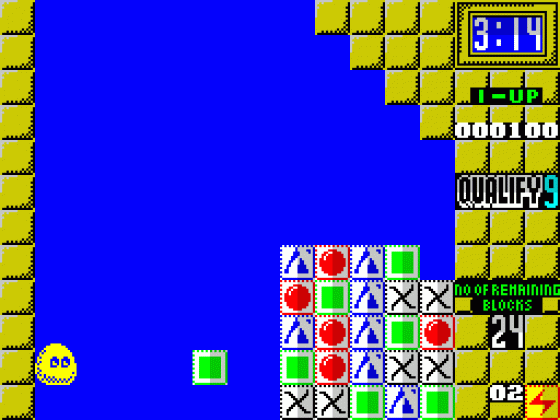
Your Sinclair
 1st December 1990
1st December 1990
Categories: Review: Software
Publisher: Ocean
Machine: Spectrum 48K/128K/+2/+3
Published in Your Sinclair #60
Plotting
Bags of colour, crispy clear sprites, and gameplay identical to the 16-bits (or, indeed, the arcade original) - how often can you say that about a conversion, eh, Specchums? Plotting is just the sort of game that transfers perfectly to the Speccy (there's no need for scrolling, and just a bunch of bricks to animate), but why look a gift horse in the mouth? This is exactly the same game as the original.
Luckily then, the coin-op was a rather appealing little puzzler. You play the cutsie 'potato man' (or whatever) in the bottom left-hand corner, and it's your job to get rid of all the coloured bricks stacked across on the right-hand side. You do this by throwing the brick you have in your hands (well, it'd be in your hands if you had any) at a like-minded brick - if you've got a red circle-coloured brick you throw it at a red circle, if you've got a Taito sign-splattered brick (the blue triangle-thing) you throw it at a Taito sign. Things aren't limited to your throwing the thing straight across the screen though - you can bounce it off the knobbly ceiling onto the top row of the stack too.
When the two bricks hit they both disappear (of course), and you receive the one placed immediately behind them, which you've then got to get rid of in the same way. And so it goes on, extra points being awarded if you manage to do anything clever like clear a whole bunch of blocks at once.

It all sounds easy enough so far, doesn't it, so what's the trick? Well, lots of concentration is required for one thing (always a bit of a problem, I find). You have to think out each move before you make it, you see - it's no use landing yourself with a block you're not going to be able to get rid of next go (because there's no suitable exposed partner), is it? Scupper yourself like that once and you're given a 'wild card' block which you can use to take out anything you like, but do it enough times and it's game over, matey.
And that's it, just about. Obviously things get a bit more complicated later on (pipe-things appear in the air between the ceiling and the blocks you want to hit, for instance, limiting the angles from which you can attack from above) but the basic gameplay is all pretty simple and appealing.
So what's the verdict? Well, as you could probably have predicted I'd say right back at the beginning, it really all depends on whether you like puzzle games or not. This is quite a good one - colourful, professionally-presented and smooth-playing, and with a fair smattering of cutsie appeal. However, it's probably not got the lasting appeal of, say, Plotting (also reviewed this issue). Each screen is just too similar to the one before - it's not a fault of the Speccy programmers, simply a limitation of the game design, which can get repetitive and samey. My attention tended to wander at times, meaning I didn't pay enough notice to planning my next move - a potentially fatal way to go about things. It's not to say I didn't enjoy the game though - far from it - just that there've been 'simple yet incredibly addictive' puzzle games one too many times already. Somehow they just don't seem quite so original anymore - which is a bit weird for a genre where original-but-simple gameplay is the stock-in-trade, isn't it?
Likeable, well-presented but slightly repetitive puzzle game. Very addictive in the short term.
Other Reviews Of Plotting For The Spectrum 48K/128K/+2/+3
Plotting (Ocean)
A review by Mark Caswell (Crash)
Plotting (Ocean)
A review by Chris Jenkins (Sinclair User)











